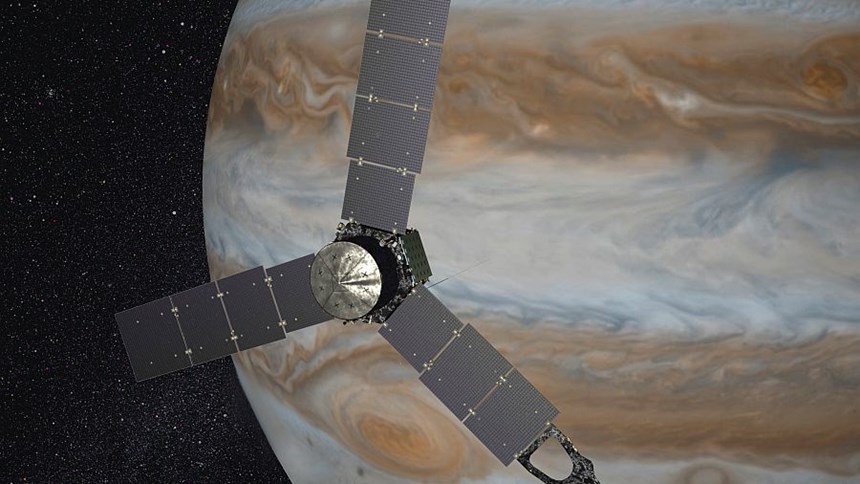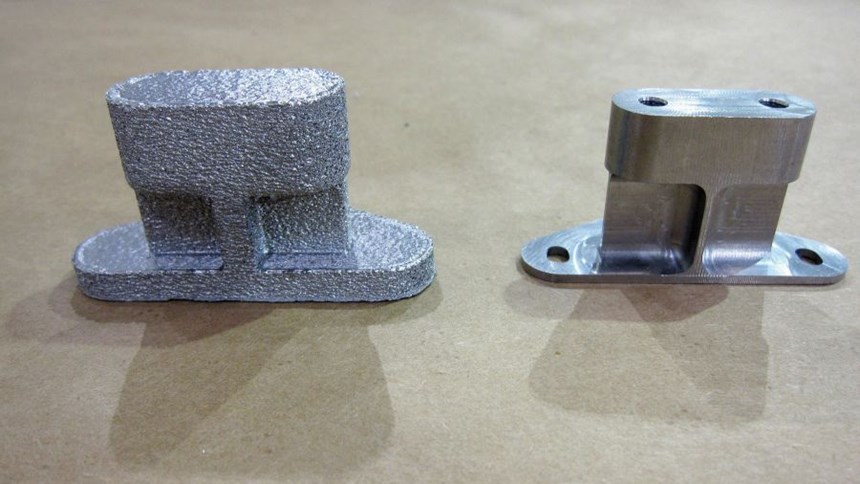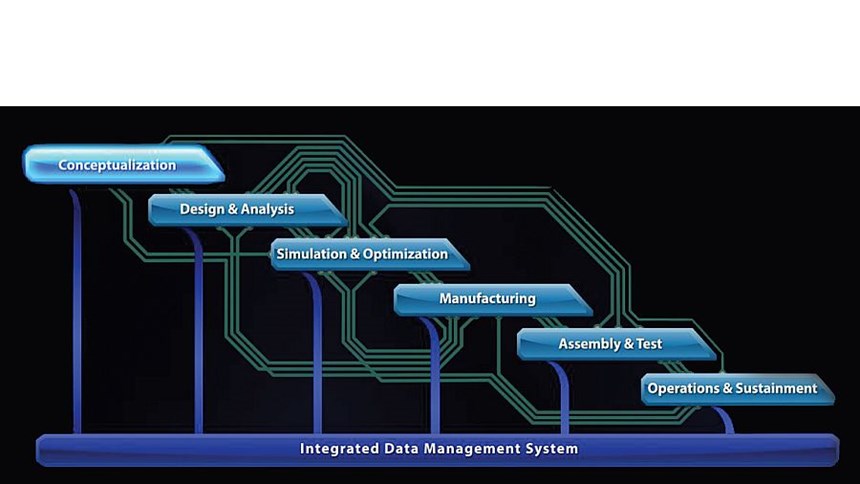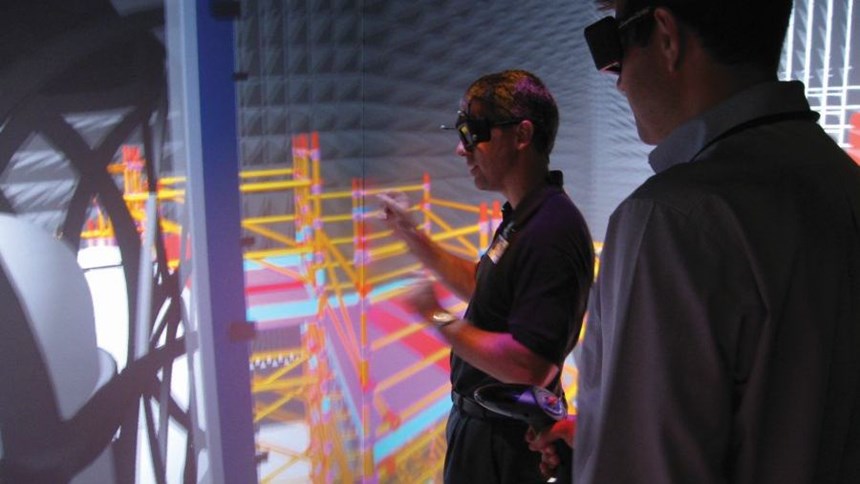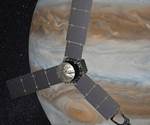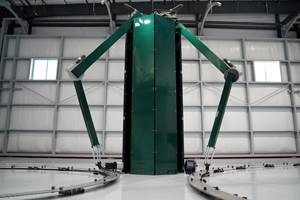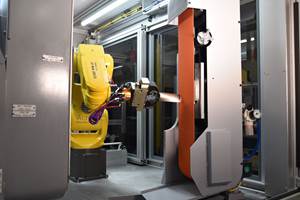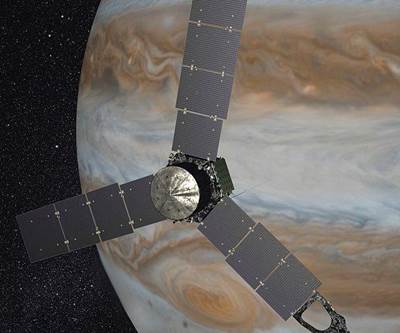Nothing But Design Intent
The way to save cost through additive manufacturing is not only to use it to eliminate unnecessary material, but also to apply it within a process that avoids unnecessary effort and interpretation by keeping all manufacturing information within the digital realm. Lockheed Martin is pursuing this ideal.
Lockheed Martin Space Systems wants to leverage additive manufacturing to achieve a product development process that is entirely digital, and therefore sweepingly different from the way we think about designing and manufacturing a product today. '
The vision is so different that it is helpful to state some simple points first. Here are two:
1. The only reason an organization ever commissions a spacecraft or satellite from Lockheed Martin is because that customer wants the machine to accomplish some mission.
2. Every manufactured component in a spacecraft or satellite serves some function that is important to this purpose.
From these two points, two further ideas follow. They are:
3. Any component or part detail that is not helpful to the mission in point 1 represents unnecessary mass that, ideally, should not be launched into space.
4. Any manufacturing step aimed at achieving something other than the direct functional intent in point 2 is an unnecessary step that probably indicates inefficiency.
Additive manufacturing—that is, making parts through 3D printing instead of casting or forging the part or machining it from solid stock—addresses both of these latter two points. In fact, in the eyes of Lockheed Martin manufacturing leaders, additive manufacturing’s greatest significance is that it takes points 3 and 4, which sound like unattainable platitudes in the context of a typical manufacturing process, and it makes them achievable and concrete.
For example, the problem of unnecessary mass can be solved. Additive manufacturing makes it possible to produce a freeform or organic shape that includes no material except what is necessary for the function of the part.
And the problem of manufacturing steps that stray from design intent can be solved as well, because additive manufacturing makes it possible to realize a freeform model exactly as that model was designed. In theory, with additive manufacturing, there is no need to translate this model into numbers such as dimensions and tolerances so that manufacturing can focus on these numbers instead of the design intent. This idea is the truly novel change in thinking, and this idea is an aspect of the vision that Lockheed Martin aims to apply not just to additive manufacturing and not just to manufacturing in general, but to the entire product development process.
The company’s term for this vison is the “Digital Tapestry.” Throughout the company, including at its Waterton site near Denver, Colorado, employees are realizing this digital-only vision in part through resources beyond the reach of smaller manufacturers. Even so, an examination of the ideas that animate this company and this facility provides a glimpse of how we might view manufacturing in the future, and also offers an insight into why the so-called “paperless” manufacturing process might logically be a gageless process as well.
Getting to Impossible
In the production of satellites and unmanned spacecraft, the advance of additive manufacturing to make end-use components has proceeded slowly and carefully. It has to. While there is no human life at stake in vessels such as these, there are instead multi-million-dollar payloads at stake, as well as ambitious missions that often relate to national defense or scientific discovery. And yet, if progress in additive manufacturing is measured in physical distance, then Space Systems has gone farther with it than anyone else, because brackets made through additive manufacturing are already on their way to Jupiter as part of NASA’s Juno spacecraft. Rather than being machined out of solid billet, these brackets were grown to near-net shape in titanium on an Arcam electron beam melting (EBM) machine.
This new approach to manufacturing is taking root at a manufacturing site with a long history. Dennis Little, Space Systems vice president of production, led my tour of the Waterton site, which is where Titan rockets were once made. The site is being renewed today, with a very different mission focused not on the production of a particular product line, but on the creation of spacecraft and space systems for various uses and customers. In addition to the additive manufacturing lab at this site, there is also extensive capability for layup and curing of composites structures, as well as CNC machining capacity in the form of modern and recently purchased machine tools. With regard to this last capacity, manufacturing engineers here foresee a future in which CNC machines work side-by-side with additive manufacturing machines to make use of both possibilities for producing parts. While additive manufacturing is not a direct replacement for machining in most cases, Lockheed Martin’s space-related manufacturing entails parts that are so complex, and sometimes needed in such small quantities, that additive manufacturing does promise to be the best way to generate many of the types of components that the facility routinely makes through machining today.
The site has had its own EBM machine for just over a year, but has been experimenting with the capability through a partnership for several years. Little says Space Systems learned the role and capabilities of additive manufacturing in part by simply allowing engineers to explore what it can do. Parts created through machining and other conventional processes were also reconceived for production via EBM. Running additive manufacturing redundantly in this way was a way to test whether additive could do the job better. If it didn’t, product development would not suffer, because the conventional part making would proceed as planned. But if additive manufacturing did produce a less expensive component, it was then possible to present this opportunity for savings to the customer. Through both success and failure at applying the process to real-world parts, Space Systems personnel are discovering what additive manufacturing can do.
An example of a success (or a near success—more on that in a bit) is the set of 12 antenna shear tie fittings on the company’s new A2100TR satellite bus. When this part was originally designed to be machined out of a solid block, machining the 12 pieces would have required 425 hours. By comparison, additively manufacturing the 12 pieces that will ultimately go into space took 220 hours. And because they had been redesigned to take advantage of the design freedom of the additive process, these parts that were made in half the time also have only half the mass of what the CNC-machined versions would have weighed. Additive manufacturing thus saves time, cost and the amount of fuel needed to deliver the craft into space.
Yet the savings might be even greater. Though additive manufacturing makes it possible to realize an optimum form for a part, the Space Systems team now realizes that getting to this form can be difficult. The design freedom is extensive, but preconceptions about the way a part “ought” to look get in the way of making full use of that freedom.
Some of the progress Lockheed Martin has made in the thinking about the antenna shear tie fitting can be seen in the image on the next page. Other possibilities for the fitting design have carried this progress even further. Little says the way to design for additive manufacturing is to consider only what function the part truly must perform, and from there try to imagine how little material might need to be in place to provide for that function. Fittings that use a mesh for strength are examples of parts that would be not just impractical to produce through conventional methods, but impossible. And to Lockheed Martin, this is a clue. The rule of thumb that those who have experimented with additive have found is this: You probably have not achieved ultimate success in the design of an additive-manufactured part until you have arrived at a form that could only be made through additive.
Beyond GD&T
Closely related to the promise of a part design that captures nothing but design intent is a product development process that does nothing but carry that design intent forward. A bigger idea than just one manufacturing step or operation, the Digital Tapestry unites (or aims to unite) the entire process from conceptualization through to sustainment. The company’s hope is to see this entire process rely on nothing for engineering information about the product except the original digital product model that was created at the outset.
To see how the Digital Tapestry would reshape manufacturing, it helps to focus on something that is not consistent with this idea. One commonplace element of part production that is decidedly not digital is the use of isolated linear feature dimensions as a proxy for the overall accuracy of the part. This practice, along with the awareness of geometric dimensioning and tolerancing (GD&T) that almost any machine shop takes for granted, is a relic of 2D representations of parts onto paper.
By contrast, Digital Tapestry manufacturing would instead be trusted to manifest the desired form of a part, whatever that form might be, within an envelope of acceptable variation all the way around the original design. In the Digital Tapestry, instead of enumerated feature tolerances indicating whether a part broke the envelope, direct digital comparison with the envelope itself would qualify the part.
The data for this comparison might be obtained by scanning the part and comparing the scan against the design model. However, Little says the more efficient way to accomplish this same goal would be to validate the part-making process in terms of its fidelity at producing a form to the precision needed. Either way, there would be no dimensions and tolerances that would be appropriate to anything like a shopfloor gage. That is, there would be no numbers to describe the part in anything like the way that a machinist might expect.
And yet, those numbers have historically done more than just validate—they also have provided a way to communicate. Design engineers conveyed their needs in shorthand by numerically defining features such as holes and mating surfaces. In this communication, there was often no point in defining less easily measured considerations such as how much material was needed in this or that area of the part, because designers took it for granted that machining could only leave plenty of stock behind. Now, with additive manufacturing tailoring a form to pure functionality, and with the Digital Tapestry potentially carrying design intent purely and seamlessly into operation, it becomes important at the outset to establish exactly what the design of a part ought to be. When a part form can be fluid because of additive manufacturing, and when linear dimensions no longer define the part because of the freedoms of the Digital Tapestry, how do engineers agree upon a concrete design?
For Lockheed Martin, part of the answer is virtual reality. One additional feature of the Waterton site is a resource called the CHIL—the Collaborative Human Immersive Laboratory. Using visors and input devices that provide the access and interface to a digital 3D space, engineers in the CHIL work together to digitally examine, simulate and modify the models for component parts or complete assemblies. That is, rather than capturing functionality needs in the form of critical dimensions and living with whatever manufacturable form happens to match those dimensions, engineers now create exactly the form that works best for all of the parties concerned, with all of those parties jointly participating in the design’s creation, and all of them able to trust that this form and only this form will be exactly realized in production.
3D printing is obviously the part-making process that is best-suited to behave this way. However, Little stresses that the Digital Tapestry idea does not depend on additive production. The use of additive manufacturing has already affected conventional production in various ways at Waterton, because the speed of additive has helped the facility discover bottlenecks in material procurement and quality that were preventing these operations from moving with similar speed. In its suitability to realize the Digital Tapestry, he says additive manufacturing will reshape conventional manufacturing in much the same way. Stripped of shopfloor gaging and in-process reworking of the part, he says, CNC machining could be reconceived to rely solely on the digital model as well.
Related Content
“Mantis” AM System for Spacecraft Uses Induction for Deposition
The metal 3D printing system melts wire without lasers. 30-foot-diameter parts are built on a rotary-feed system that eliminates the need for a large machine frame or gantry.
Read MoreAt General Atomics, Do Unmanned Aerial Systems Reveal the Future of Aircraft Manufacturing?
The maker of the Predator and SkyGuardian remote aircraft can implement additive manufacturing more rapidly and widely than the makers of other types of planes. The role of 3D printing in current and future UAS components hints at how far AM can go to save cost and time in aircraft production and design.
Read More8 Cool Parts From RAPID+TCT 2022: The Cool Parts Show #46
AM parts for applications from automotive to aircraft to furniture, in materials including ceramic, foam, metal and copper-coated polymer.
Read MoreAircraft Engine MRO: How Additive Manufacturing Plus Robotic Finishing Will Expand Capacity for Blade Repair
AM offers the chance to bring fast, automated processing to individualized, part-by-part restoration of turbomachinery. A cell developed by Acme Manufacturing and Optomec is able to automatically repair 85,000 unique aircraft engine blades per year.
Read MoreRead Next
Additive Manufactured Components Reach Jupiter
The Juno spacecraft includes titanium waveguide brackets made through AM.
Read MoreAdditive Manufacturing of Brackets Saves 1 Kilogram per Satellite
Because of complexity, material and quantity, spacecraft and satellite components are good candidates for additive production.
Read MoreHybrid Additive Manufacturing Machine Tools Continue to Make Gains (Includes Video)
The hybrid machine tool is an idea that continues to advance. Two important developments of recent years expand the possibilities for this platform.
Read More
.jpg;width=70;height=70;mode=crop)

